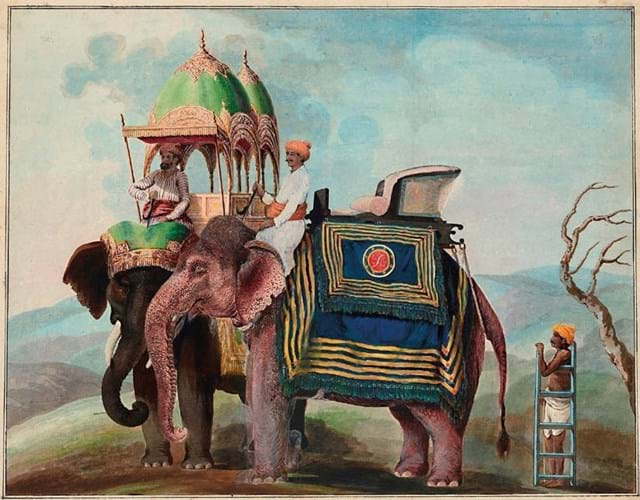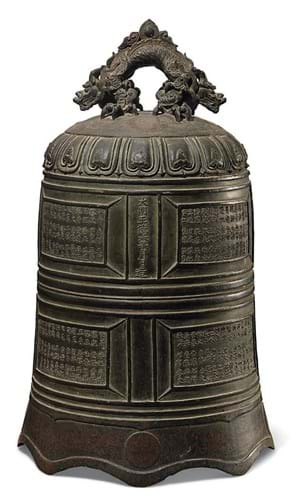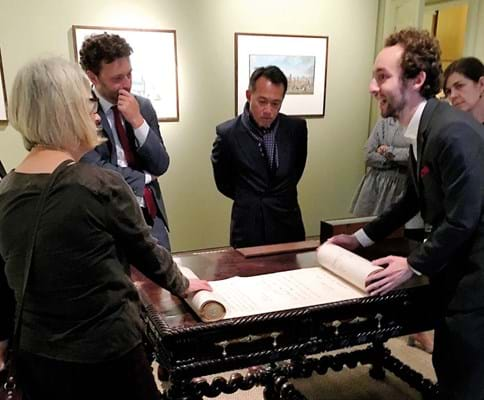Dealer: Grace Tsumugi Fine Art

A mid-20th century lacquer writing table and writing box set by Moriya Shotei (1890-1972) from Grace Tsumugi Fine Art.
A mid-20th century lacquer writing table and writing box set by Moriya Shotei (1890-1972) decorated with scenes of day and night, seascapes and cranes, and featuring a range of different lacquer techniques and styles.
Dealer: Jonathan Tucker Antonia Tozer Asian Art
A 23½in (60cm) long polished stone carving of a recumbent Nandi bull realistically modelled with a pronounced dewlap. The bull is associated with Lord Shiva and representations of the animal are often found in temples.
This example, which comes from a private English collection, is from Nepal, probably from the Kathmandu Valley, and is dated to the 13th or 14th century.
Dealer: Simon Ray Indian & Islamic Works of Art

This stone carving of a celestial beauty from India, Chalnkya, Rajasthan or Gujerat dated to the 11th-12th century is shown by Simon Ray Indian & Islamic Works of Art.
A 23in (59cm) high stone carving of a celestial beauty from India, Chalnkya, Rajasthan or Gujerat dated to the 11th-12th century. Probably depicting an asparas or yakshi, who would have guarded gods and goddesses on an external temple wall, the figure is shown standing in a graceful tribhango (S curve) with one arm held above her head (Ex the Cleveland Museum of Art).
Dealer: Priestley & Ferraro

Priestley & Ferraro exhibit this early Ming (Yongle mark and period) imperial red lacquer bowl stand carved with dragons and lotus.
An early Ming (Yongle mark and period) imperial red lacquer bowl stand carved with dragons and lotus. The bowl measures 6½in (16.5cm) in diameter and has a needle-incised six-character Yongle mark.
Part of a rare group of Ming bowl stands carved in the same imperial style and the only known example decorated with dragons from the Yongle reign, it has a 1960s provenance to a French private collection.
Dealer: Francesca Galloway

Francesca Galloway will show this watercolour on paper of two caparisoned elephants from Murshidabad (1795-1807).
A watercolour on paper of two caparisoned elephants from Murshidabad (1795-1807). Measuring 18½ x23½in (47 x 60cm), the work is taken from an album of hitherto unknown watercolour paintings of festive and religious events and architectural views of houses, executed by Indian artists working at the end of the 18th century.
Research by Dr Rosie Llewellyn Jones has revealed the owner of this album to be Louisa Parlby. She was married to James Parlby, an engineer living near Murshidabad and assembled these scenes of Indian life.
Auctioneer: Chiswick Auctions

This painting created in 1921 by the artist Xu Naigu (1785-1835) set on a 98ft (30m) long handscroll, features 98 inscriptions by various artists, scholars and politicians and other notable figures spanning 127 years from 1921-48. From Chiswick Auctions.
A painting created in 1921 by the artist Xu Naigu (1785-1835) set on a handscroll, which features 98 inscriptions by various artists, scholars and politicians and other notable figures spanning 127 years from 1921-48.
The scroll is more than 98ft (30m) long and would have been displayed at literati gatherings featuring artistic and philosophical debates with honoured guests invited to contribute. It comes with a provenance back to its original creation and was given to the vendor by her father as a wedding gift in 1974.
Auctioneer: Christie’s London

A 3ft (93cm) high Ming dynasty cast bronze bell with a suspension loop formed as a pair of dragons. From Christie’s London.
A 3ft (93cm) high Ming dynasty cast bronze bell with a suspension loop formed as a pair of dragons.
The bell’s walls are cast with 314 names as well as a reign mark reading Da Ming Zhengde lui niam yue ri zao and a panel with the inscription huangdi wan sui wan wan sui (long live the emperor).
One of only a handful of similar Ming dynasty bells that have been published, it belongs to a noble Scottish gentleman in whose family it has descended since it was acquired in the first half of the 20th century.
Auctioneer: Bonhams Bond Street

Bonhams Bond Street offers this roiro (black lacquer) panel by Shibata Zeshin 1807-91, decorated with bell crickets on grasses growing on a bank set against a silver lacquer full moon and embellished with silver dewdrops.
A 17½in x 2ft (44.5 x 761cm) roiro (black lacquer) panel by Shibata Zeshin 1807-91, decorated with bell crickets on grasses growing on a bank set against a silver lacquer full moon and embellished with silver dewdrops. It is signed lower right Made by Zeshin aged 71 with a red lacquer seal and set within a removable narrow gold lacquer Western-style frame. From the Misumi Collection of lacquer and paintings.
The judge’s tale
ATG’s Anne Crane is one of the panel given the task of deciding who should win an AAL Award. Here, she provides an insight.
If you want a whistle-stop tour round the West End’s Asian galleries taking in some of the most interesting artworks London has to offer, try being on the judging panel for Asian Art in London.
Over the course of a few hours you can be whisked from ancient China to the Himalayas, and Mughal India to Meiji-era Japan, as you survey pieces the participants have put forward to win the two AAL Awards sponsored by Antiques Trade Gazette and Apollo.
It’s an energetic day. The panel, made up of around half a dozen people (museum curators and arts journalists), selects a shortlist of works from those submitted by prospective candidates to view in more detail.
These visits offer the opportunity to examine the pieces closely and quiz their owners on details of background, provenance and comparative examples.
What is on the judges’ tick list? Quality, of course – the piece must be a very good example of its type – but that is not all.
You look for something a bit out of the ordinary, with perhaps an interesting back story or some distinctive quality that gives it that little bit extra. Sometimes an object grabs your attention immediately while others will grow on you as you look more carefully and the details and context are explained.
That is why, after viewing, the panel retires to discuss, debate and come to a final agreement. Past prize winners, which have ranged from a Song dynasty Tenmoku bowl on stand and a trio of 8th-9th century gold Buddhas to a contemporary gouache, gold leaf and ink work on paper, illustrate these factors and highlight the diversity of London’s Asian expertise, one of the main goals of this 20-year-old initiative.

















